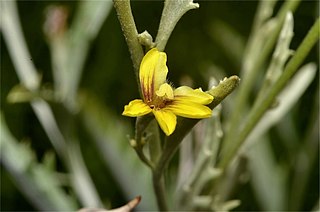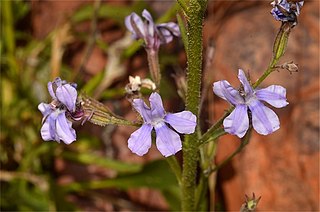
Goodenia stobbsiana is a species of flowering plant in the family Goodeniaceae and is endemic to the north-west of Western Australia. It is a sticky, much-branched, perennial subshrub with egg-shaped to lance-shaped leaves with the narrower end towards the base and thyrses of blue flowers.

Goodenia azurea, commonly known as blue goodenia, is a species of flowering plant in the family Goodeniaceae and is endemic to northern Australia. It is an erect, dense, spreading or sprawling, glaucous, perennial herb with egg-shaped leaves with the narrower end towards the base, racemes or thyrses of bluish-purple flowers with leaf-like bracts, and oval to cylindrical fruit.
Goodenia bicolor is a species of flowering plant in the family Goodeniaceae and is endemic to north-western Australia. It is an annual or ephemeral herb with lance-shaped to egg-shaped leaves with the narrower end towards the base, racemes of yellow or yellow and purple flowers and elliptical fruit.
Goodenia crenata is a species of flowering plant in the family Goodeniaceae and endemic to north-western Australia. It is a perennial, herb with oblong, elliptic or egg-shaped leaves in a rosette at the base of the plant, and leafy racemes of yellow flowers.
Goodenia eremophila is a species of flowering plant in the family Goodeniaceae and is endemic to inland areas of Western Australia. It is an ascending herb with linear to elliptic leaves and thyrses of blue flowers.
Goodenia faucium, commonly known as the Mount Liebig goodenia, is a species of flowering plant in the family Goodeniaceae and is endemic to the Northern Territory. It is a shrubby perennial with narrow elliptic to egg-shaped, toothed leaves and racemes of yellow flowers.

Goodenia grandiflora, commonly known as large-flowered goodenia, pinnate goodenia or mountain primrose, is a species of flowering plant in the family Goodeniaceae and is endemic to Australia. It is an erect under-shrub with toothed, egg-shaped to round leaves and racemes or thyrses of yellow, white or purplish flowers.
Goodenia hartiana, commonly known as Hart's goodenia, is a species of flowering plant in the family Goodeniaceae and is endemic to Western Australia. It is an erect to spreading perennial herb or subshrub with lance-shaped to egg-shaped leaves with the narrower end towards the base, racemes of blue or purple flowers and oval to cylindrical fruit.

Goodenia heterochila, commonly known as serrated goodenia, is a species of flowering plant in the family Goodeniaceae and is endemic to arid areas of Australia. It is an erect or ascending perennial herb with lance-shaped to egg-shaped stem leaves with the narrow end towards the base, and racemes of yellow flowers with a brownish centre.

Goodenia hirsuta is a species of flowering plant in the family Goodeniaceae and is endemic to northern Australia. It is a hairy, prostrate to low-lying perennial herb with narrow egg-shaped leaves at the base of the plant, racemes of hairy yellow flowers and oval to elliptic fruit.

Goodenia holtzeana is a species of flowering plant in the family Goodeniaceae and is endemic to northern parts of the Northern Territory. It is a prostrate to ascending or erect annual plant with egg-shaped to lance-shaped stem-leaves with the narrower end towards the base, and racemes of yellow flowers with brownish markings.

Goodenia modesta is a species of flowering plant in the family Goodeniaceae and is endemic to central Australia. It is an erect perennial herb with leaves lance-shaped in outline at the base of the plant, and racemes or thyrses of yellow flowers.

Goodenia mueckeana is a species of flowering plant in the family Goodeniaceae and is endemic to central Australia. It is an ascending, perennial herb with toothed, linear to egg-shaped leaves and racemes or thyrses of yellow flowers.
Goodenia purpurascens is a species of flowering plant in the family Goodeniaceae and is native to northern Australia and New Guinea. It is usually a perennial herb with linear to lance-shaped leaves at the base of the plant, and thyrses or panicles of purple flowers.

Goodenia ramelii is a species of flowering plant in the family Goodeniaceae and is endemic to central Australia. It is a perennial herb with toothed, elliptic leaves in a rosette at the base of the plant, and racemes of blue flowers.
Goodenia rupestris, commonly known as rock hand-flower, is a species of flowering plant in the family Goodeniaceae and is endemic to the Northern Territory section of the Petermann Ranges. It is an ascending or pendulous perennial herb with crowded elliptic to lance-shaped leaves with the narrower end towards the base, and racemes of yellow flowers.

Goodenia sepalosa is a species of flowering plant in the family Goodeniaceae and is endemic to northern Australia. It is a prostrate to ascending herb with narrow oblong to lance-shaped leaves, the narrower end towards the base, and racemes of yellow flowers.
Goodenia sericostachya, commonly known as silky-spiked goodenia, is a species of flowering plant in the family Goodeniaceae and is endemic to a restricted area in the west of Western Australia. It is an erect herb or shrub with silvery hairs, lance-shaped to egg-shaped leaves at the base of the plant and thyrses of blue to pinkish-mauve flowers.
Goodenia suffrutescens is a species of flowering plant in the family Goodeniaceae and is endemic to inland areas of north-eastern Western Australia. It is an undershrub with low-lying branches, toothed, lance-shaped to egg-shaped leaves with the narrower end towards the base, and thyrses of blue flowers.
Goodenia viscidula is a species of flowering plant in the family Goodeniaceae and is endemic to northern Australia. It is an erect annual herb with sticky, hairy foliage, egg-shaped to lance-shaped leaves with the narrower end towards the base, and thyrses or panicles of purplish-blue flowers.










